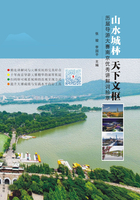
Five-Kilometer Qinhuai

赛项:2014年第四届南京市导游大赛
选手:李盈(三等奖)
选送:秦淮区旅游局
Ladies and gentlemen, good morning, My name is Li Ying, and my English name is Elena .
After crossing Wende Bridge, here is the well-known Qinhuai River, the “Mother River” of Nanjing, which is also the cradle giving birth to the ancient civilization of Nanjing city. This is the core scenic area of “Five-kilometer Qinhuai”.
First of all, we can see a big screenwall painted in bright vermilion decorated by 2 dragons playing with a pearl. The screenwall was built in the Ming Dynasty with 110 meter long and 10 meter high, which was the biggest one of its kind in China.
On your left hand, there is the 100-year-old Kuixing Pavilion. Under the pavilion, there is a corridor called Kuixing Corridor for examinees waiting for entering the examination hall in times of imperial examination.
Kuixing Corridor is now one part of Jiangnan Imperial Examination Hall. The examination hall was built in the Southern Song Dynasty and became the biggest venue for examination of China in the Ming and Qing Dynasties with as many as 20,644 examination cells. In the history, famous examinees like Tang Bohu, Wu Cheng'en, Zheng Banqiao, and Chen Duxiu started their provincial examinations here. Officials in the Ming Dynasty like Lin Zexu, Zeng Guofan, Li Hongzhang, Zuo Zongtang were the supervisors here. Dear friends, a mini dock appears on your left hand, from which you can step in the examination hall and experience the culture of imperial examination.

桃叶渡
The bridge linked to Jiangnan Imperial Examination hall is Wenyuan Bridge, the name of which implies the rightness and long history of Confucianism as well as (other bridges on the river, like) Wende Bridge and Wenzheng Bridge.
This bridge is called Pingjiang Bridge. On the right bank of the bridge, there is the elegant Bailuzhou Park. Famous poet Li Bai had visited Qinhuai River for several times and left many poems about Bailuzhou Park. The park is a quiet island amid the busy city and also a bright pearl in Qinhuai River scenic area. When we cross Pingjiang Bridge, you can see the park on your right hand.The park is a quiet island amid the busy city and also a bright pearl in Qinhuai scenic area.
Dear guests, here we come to the oldest scenic spot Taoye Ferry. Taoye Ferry was one of the ancient scenic spots in Nanjing and reputed as one of Jinling 48 most famous scenic spots. There was a great calligrapher in the Eastern Jin Dynasty called Wang Xianzhi, who made Taoye as his beloved concubine. In ancient times, boats on the wide Qinhuai River often overturned because of the strong waves which frightened Taoye a lot. For comforting Taoye, Wang Xianzhi wrote a poem named “Taoye” for the lady to express his deep and true love.
Ladies and gentlemen, after crossing this Wenzheng Bridge, the entrance to inner Qinhuai River, East Water Sluice is right in front of you. East Water-Sluice has a history of over 1,000 years. Qinhuai River is divided into two parts by the sluice: the inner one and the outer one. East Water-Sluice had three layers with the bottom layer for adjusting the water-level and two upper layers served to place commanders and soldiers. In the Ming Dynasty, after establishing the capital in Nanjing, Zhu Yuanzhang expanded East Water-Sluice into Tongji Water-Sluice where the prosperity of Qinhuai River area had begun.
Qinhuai Scenic Area witnesses the ups and downs of Nanjing city, from depression to boom, from sorrow to joy. This mysterious history and culture is waiting for all of you to discover and explore.
关键词点击
十里秦淮
千百年来,秦淮河哺育着古城南京,“锦绣十里春风来,千门万户临河开”,夫子庙附近的河房是绮窗丝幛,十里珠帘,灯船之盛,甲于天下。秦淮河风味小吃是我国四大小吃群之一。夫子庙地区茶楼饭店,街边小吃,满目皆是,形成独具秦淮传统特色的饮食集中地。经过多年的努力,秦淮河地区几家点心店的作品,因工艺精细,造型美观、选料考究、风味独特而著称,南京秦淮区风味小吃研究会于1987年9月正式命名这八套秦淮风味名点小吃为“秦淮八绝”。
经过修复的秦淮河风光带,以夫子庙为中心,秦淮河为纽带,包括瞻园、夫子庙古建筑群、白鹭洲、中华门城堡,以及从桃叶渡至镇淮桥一带的秦淮水上游船和沿河景观,可谓集古迹、园林、画舫、市街、河房厅和民俗民风于一体的旅游线,极富情趣和魅力。
知识拓展
桃叶渡
桃叶渡是秦淮河上的古渡,位于秦淮河与古青溪水道合流处附近,南起贡院街东,北至建康路淮清桥西,又名南浦渡。桃叶渡位列于金陵四十八景内。在原渡口处立有“桃叶渡碑”,并建有“桃叶渡亭”,从六朝到明清,桃叶渡处均为繁华地段,河舫竞立,灯船萧鼓。
清顺治年间,孝陵卫人金云南迁居渡口,见渡口非常拥挤,常有人落水而死,便捐建木桥,题名“利涉桥”(取便利涉水之意),公元1663年(康熙二年)易木桥为石桥。1984年,有关部门在渡口原址立桃叶渡碑。
清人张通之在《金陵四十八景题泳》“桃叶临渡”一景中写道:“桃根桃叶皆王妾,此渡名惟桃叶留,同是偏房犹侧重,秦臣无怪一穰侯。”诗文道出了桃叶、桃根姊妹俩,同为东晋大书法家王献之的小妾;因王献之当年曾在此迎接过爱妾桃叶,古渡口由此得名。王献之当年曾作《桃叶歌》曰:“桃叶复桃叶,渡江不用楫;但渡无所苦,我自迎接汝。”从此渡口名声大噪。这首载之《古今乐寻》中之诗,为乐府吴声流韵,至南朝陈时犹“盛歌”之。《桃叶歌》一直保存在明乐的乐曲之中,至今日本的明清乐中还有这首歌曲。“桃叶临渡”遂成千古佳胜和久传不衰的风流佳话。
现在的桃叶渡,老宅是吴敬梓故居,里面有一碑坊,上面清晰地刻画了“古桃叶渡”几个字,两边是“楫摇秦代水,枝带晋时风”的坊联。